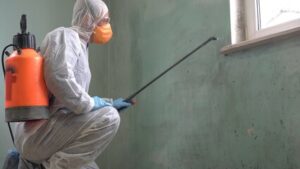Septic Tank Cleaning Perth is necessary to ensure your septic system works properly. It protects your home’s sewage and waste systems, saves money on repairs, and keeps you and your family healthy.
Sewage backups in your home are the most obvious sign that your septic tank needs cleaning. A professional service checks the liquid level, lowers a vacuum hose to pump out the tank contents, and cleans the interior of the tank.

A clogged drain is one of the most obvious signs that your septic tank needs cleaning. Fortunately, a few at-home hacks can fix minor clogs, but persistent or reoccurring ones may indicate a more serious problem. In these cases, it’s best to call the professionals so that they can take a look and determine what is causing the issue.
A septic system clog is often caused by non-biodegradable waste materials being flushed down the toilet. This includes cigarette butts, cotton balls and swabs, menstrual hygiene products and condoms. These items can clog the septic tank’s outlet baffle or effluent filter, which is responsible for dispersing sewage into your septic field and surrounding soil.
Another common cause of septic tank clogs is a buildup of FOGs (fats, oils and grease). These substances can create a hard crust that blocks the flow of wastewater in the septic tank. They can also block the septic tank vent, which is crucial for proper gas ventilation.
Even with regular septic tank cleaning and careful waste disposal, you might experience a clogged drain from time to time. When this occurs, it is typically a sign that you need to have the septic tank pumped. A professional can use a septic tank pump hose to clean out the clog and restore full flow of wastewater throughout your home.
Persistent foul odors from your drains or yard are another indication that it’s time to call a pro. These odors are created by hydrogen sulfide, which is released when the organic material in your septic system decomposes. The smell can be especially strong if the septic tank vent is blocked.
The best way to prevent these problems is by performing regular septic tank cleaning and keeping an eye on what goes down your drains. It is also important to never pour chemicals down your drains, as they can kill the helpful bacteria that break down waste and keep your septic system healthy. Instead, opt for septic tank safe cleaners that are biodegradable.
Foul Odors
A septic system that’s been properly maintained shouldn’t smell, even when it’s full of waste. If you smell sewage in your home or yard, it’s time to call a professional septic tank company for an inspection and pumping. They can use a vacuum truck to remove all the waste and sludge in your tank, and they will check for signs of damage or clogs in the drain field or leach line as well.
If a clog is causing the septic odor, the plumber will have to clear the blockage. In some cases, it may be difficult to determine the source of the clog, especially if it’s a deep one. In these cases, it may be necessary to dig up part of the septic tank and pipework, and a professional can then inspect the entire system for any other issues.
Odors can also be caused by a change in the pH level of your septic tank. Microorganisms that break down waste solids in the septic tank need a pH level of between 6.8 and 7.6 to survive. If the level becomes too acidic, it can cause a foul odor like rotten eggs. Homeowners can help correct the pH level by pouring a cup of baking soda down any toilet or sink drain once a week.
Another potential cause of septic tank odors is a failing wax seal in your toilet. The wax seal, which stops water from leaking around the bottom of your toilet, can become worn out by frequent flushing of non-flushable items like paper towels, tampons, wet wipes, and coffee grounds. It’s important to only flush human waste and toilet paper, and to have your septic tank pumped every three to five years.
The vent stack, which sends septic tank gases out of your house, can get blocked by leaves or other debris that gets into the vent opening. A professional can evaluate the septic tank vent and vent stack and make recommendations if any issues are found.
Damage
If a septic system is allowed to become overtaxed, solid materials will start to build up in the tank. This makes it harder for wastewater to pass into the drain field, which will ultimately cause sewage backups in your home. Regular septic tank cleaning prevents these issues from occurring by keeping your tank at its best performance level.
Another issue that arises if a septic tank isn’t cleaned regularly is the possibility of wastewater seepage into the surrounding soil and water sources. Untreated sewage contains pathogens and other contaminants that can make people sick. It also poses a risk to aquatic life and can contaminate groundwater, surface water and marine waters.
One of the most obvious signs that your septic tank needs to be cleaned is a foul smell coming from your drains and yard. This is caused by a buildup of gasses such as hydrogen sulfide. These gasses are produced as the waste inside the septic tank breaks down. A clog in the tank’s ventilation system will trap these gasses, causing them to seep out of the septic tank and into your home or yard.
Other signs that your septic tank isn’t working properly include standing water in your yard or around the septic system drainfield. This is because the tank is full and unable to absorb any more wastewater.
The septic system can also be damaged by what you flush or put down the drain. Non-biodegradable materials like cigarette butts, sanitary wipes, diapers and paper towels should never enter the septic system. You should also avoid using caustic chemical drain openers, as these can destroy the bacteria in your septic tank. It is also a good idea to limit your use of garbage disposals, as they add 50 percent more solid waste to the tank than a toilet does.
Getting your septic tank pumped and cleaned on a routine basis helps you reduce the need for costly emergency repairs or replacements of the tank and other parts of your septic system. It will also help protect the environment and your family’s health by preventing harmful contaminants from entering the groundwater, waterways and coastal areas.
Safety
If you hear gurgling sounds from your toilets or smell foul waste odors around your house, it may indicate that the septic system is overtaxed and needs cleaning. Sewage odors aren’t just unpleasant, but they can also carry pathogens that can cause serious health problems. If you suspect that your septic tank is full or has a clog, shut off all water to your home and call a septic tank service immediately.
Professional septic tank cleaners take several safety precautions to protect themselves, their clients, and the environment during septic tank cleaning. They wear personal protective equipment like rubber gloves, goggles, and masks to reduce the risk of exposure to sewage liquids and solids. They also dispose of all contaminated materials in a proper hazardous waste disposal site.
In addition to cleaning the septic tank, septic tank cleaners remove clogs from the inlet and outlet drains. They use shovels to loosen the soil covering the tank so they can open the lid and uncover the inlet and outlet sides of the septic system. Then they empty the septic tank completely and thoroughly. Once the solids have been removed, they pour the liquid wastewater into the drain field, where natural filtering takes place in sandy or limestone soil.
You can extend the time between septic tank cleanings by reducing your household water consumption. This includes using less water in your washing machine, showers and toilets. It’s also a good idea to reduce the amount of bleach, paint, hair and paper products that you flush down your drains. These can cause clogs that prevent your septic tank from draining properly and cause wastewater to back up into your home.
Keeping your septic system in good working condition will help to extend the time between cleanings. Be sure to use non-toxic, biodegradable household cleaners and avoid putting anything down the drain except human waste, toilet paper and non-fluffy, white toilet paper. In addition, never dump grease or oil down the drain and if you do paint your home, rinse rollers in a bucket of water before disposing of them.








